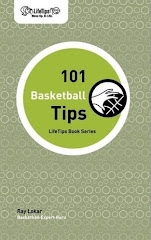In light of the
170-35 blow-out victory by Yates High School over Lee High School in Houston, I though I'd repost a newsletter topic I
wrote first back in 2004, with a few additions/edits.
Coaches should try to schedule games against teams that will present somewhat of a challenge. While padding the schedule with wins may seem attractive, playing teams of inferior talent will actually hinder a teams development. However, many times in preseason tournaments obvious mismatches between two teams occur or a league may be set up where you have to play someone far inferior. The tough thing for coaches in this situation is figuring out a way for their team to get everything out of the game that they can, without humiliating the opponent.
Coaches, in the 1st half - do your thing, play your game, anything goes. If the lead starts to get real big, your regulars may not be benefiting anyway, so play your substitutes a little more. Mix up some lineups and play a couple of subs with the starters. You may find a diamond in the rough. Try a player at a different position. You may get a pleasant surprise. If you know ahead of time it might go this way, it's not a bad time to reward someone and give someone a start
When playing against teams or players who are not quite as talented, it is still important to play at YOUR best. Do not drop your level of play simply to defeat the opponent. Compete against your own personal best every time out, and try to achieve that. To do that AND respect your opponent, there may be some additional strategies that you employ.
2nd half (or at least the 4th quarter) Adjust your strategy to practice specific situations that you may face somewhere down the line. *The key point is to EXPLAIN this to the players so that they realize that they ARE NOT letting up but actually working on strategies that will make them better.
1) Play everyone and mix up your lineup. Insert a few subs with a couple of starters. The starters work hard and still deserve to get some time. This mixes it up.
OBJECTIVE:you never know when an injury or foul trouble (maybe both) may force those players into an increased role. Prepare them to play with the regulars
2) Don't press full court. I don't care if you are a pressing team and you "need to work on it". What kind of work are you really getting against that type of inferior competition?
OBJECTIVE:pressing bad competition causes players to take gambles that may not work against better teams, and those are the teams that you are supposed to be preparing to beat. Continuing to press may develop bad habits that hurt you down the road. Avoid those bad habits by calling off the press or changing to a different type of pressure.
3) Don't get steals and shoot uncontested layups. Do that in layup lines. Pull it out and work on some sort of offensive set or continuity
OBJECTIVE: this will help you run out the last possession of a game when you have a one point lead. Or better yet when it's tied with 35 seconds to go and you want to take the last shot. And then demand only inside shots. THAT will help you get better.
4) Play a tight zone or a pack m2m
OBJECTIVE: play as if you need to stop some big post player or a team that can't shoot outside, on at least a crucial possession.
5) Don't deny passes and get steals in the half court. Force THEM to take time off of the clock.
OBJECTIVE:play as if you were playing a team much quicker than you that might be able to beat you on some backdoor plays. Against those teams the deeper you get in the shot clock-the bigger advantage the defense has.
6) Block out and rebound - then WALK IT UP!
OBJECTIVE:play as if you were protecting an 8 pt lead in the final minute. At that point in a game you don't want to play a fast pace and create more possessions and opportunities for the opponent to come back.
If a team did that for an entire half using 35 seconds and even assuming that the losing team didn't 'play along' and shot in their first 10 seconds, the team would have to shoot 100% just to score 40 pts in the 2nd half. A more normal 50% and they score 20 pts. Maybe the other team scores a few and you only win by 40.
I loved winning by 15-20. Safe enough lead not to blow it in the last couple of minutes and big enough to get all subs in the game. Does not demoralize the opponent and lets you work on the parts of the game that you need to improve to beat the good teams. Under 10 pts - anything can happen. Who cares what you do against the bad teams, you'll beat them anyway!
Practice what you need not just to win the game - but to beat the best.









